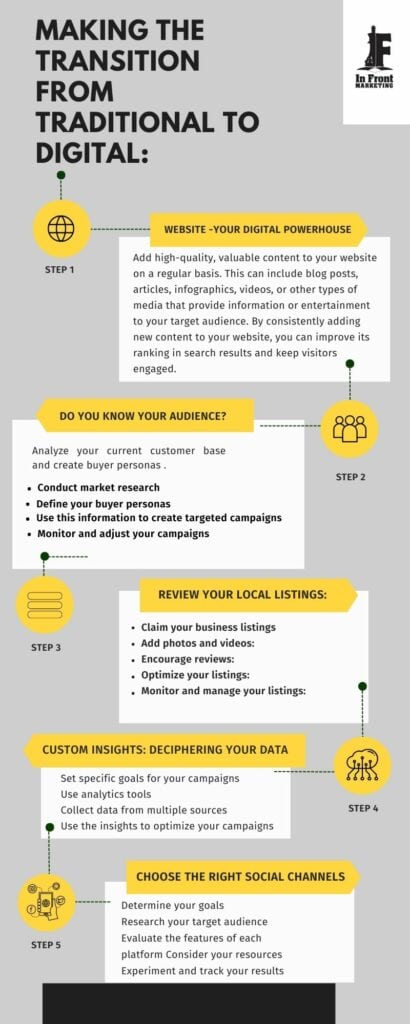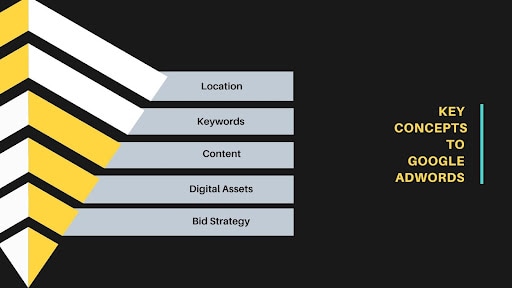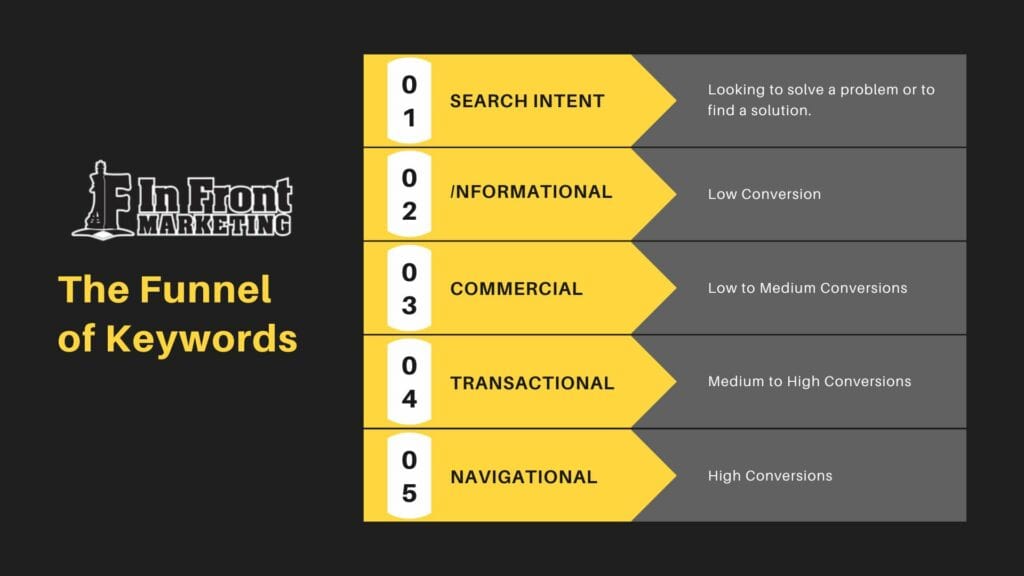The shift from traditional marketing to digital marketing has revolutionized the way businesses reach and engage with their audience. Gone are the days when traditional media was the main source of traffic for businesses.
Today, digital marketing enables personalized consumer experiences, which are essential for the success of your business. While traditional marketing tactics can still play a role in your marketing strategy, it’s important to recognize that digital marketing is now at the forefront of reaching and engaging with your target audience. Don’t get left behind – embrace the power of digital marketing to drive your business forward.
As a business, it can be intimidating to adapt to the constantly evolving landscape of digital marketing. Platforms and strategies are constantly changing, leaving even the most seasoned professionals feeling uncertain.


In Front Marketings Process to Transforming Your Traditional Marketing Tactics To Digital
But don’t let this deter you – the digital world is full of opportunities for your career and business. If you’re considering making the switch from traditional to digital marketing, or simply want to upskill, this blog will provide you with an overview and help you identify your transferable skills.
Digital marketing has fundamentally changed the way we interact with our potential customers, giving them more control over how they consume advertising. Technology like artificial intelligence and virtual reality are becoming increasingly prevalent in marketing campaigns, and it may seem like everything is moving too quickly to keep up with. But with the right mindset and determination, you can thrive in this exciting and dynamic industry.
Website – Your Digital Powerhouse & Presence
First and foremost, take a good look at your website. It should be the cornerstone of your digital marketing strategy. It’s the hub of your online presence and where customers learn more about your company and what you offer. Make sure your website is up-to-date, mobile-friendly, and optimized for search engines.
It’s also a good idea to add high-quality, valuable content to your website on a regular basis. This can include blog posts, articles, infographics, videos, or other types of media that provide information or entertainment to your target audience. By consistently adding new content to your website, you can improve its ranking in search results and keep visitors engaged.
Are you aware of who’s engaging with your content? 🤔
If not, then #infrontyyc has the solution for you. Our innovative audience profiling allows you to identify and understand your target audience’s wants, needs, and interests.
Do You Know Your Audience?
Next, it’s important to understand your audience. Analyze your current customer base and create buyer personas to get a better understanding of their needs and interests. This will help you create effective digital marketing campaigns that resonate with your target audience.
To build out this idea, you could consider the following:
- Conduct market research: This can include surveys, focus groups, or online analytics tools to gather data on your audience.
- Define your buyer personas: Use the information you gather from your market research to create detailed profiles of your ideal customers. Be sure to include information about their demographics, pain points, goals, and interests.
- Use this information to create targeted campaigns: Once you have a good understanding of your audience, you can use this information to create digital marketing campaigns that are tailored to their needs and interests. This can include email marketing campaigns, social media ads, or targeted content on your website.
- Monitor and adjust your campaigns: As you run your campaigns, be sure to track their performance and make adjustments as needed. This can help you fine-tune your marketing efforts and ensure that you are reaching your target audience effectively.
What better way to explore your local area than by checking out the amazing businesses, places, and services that call it home?
At #infrontyyc, we are committed to making sure you are in the know about all the amazing things to do, see, and experience in your city.
Look At Your Local Listings – What Do You See?
Make sure your business is listed in all the local directories, such as Google My Business, Yelp, and Bing Places. These directories will help customers find your business and provide important information about your services and location.
Here are a few additional points you can include:
- Claim your business listings: In addition to the directories mentioned, there may be other local or industry-specific directories that are relevant to your business. Be sure to claim your listings on these platforms and provide accurate and up-to-date information about your business.
- Add photos and videos: Visual content can help attract potential customers to your listings and give them a better sense of what your business has to offer. Consider adding photos of your products or services, as well as videos that showcase your business in action.
- Encourage reviews: Customer reviews can be a powerful marketing tool, as they provide social proof of the quality of your business. Encourage your satisfied customers to leave reviews on your local business listings.
- Optimize your listings: Be sure to include relevant keywords in your business descriptions and titles, as well as in any categories or tags. This can help improve the visibility of your listings in search results.
- Monitor and manage your listings: Regularly check your local business listings to make sure the information is accurate and up-to-date. You should also respond to any customer reviews or inquiries in a timely and professional manner.
Your #customer insights have powerful stories to tell. But do you know how to interpret them?
At #infrontyyc, we’ve got you covered! Use our advanced analytics tools to decipher even the toughest customer data. Get ready to unearth untold secrets and gain valuable insights into their buying habits! #DataAnalytics
Achieve success in no time with easy-to-use dashboards and reports that will save you processing time. Unlock the potential of your customers’ feedback today! #SpeedUpYourBusiness
Customer Insights Speak Volumes – Can You Decipher Your Data?
Use customer data to gain valuable insights into how your customers interact with your digital marketing campaigns. This will help you understand which channels are most effective, what content resonates with customers, and what strategies need to be optimized.
Here are a few additional points you can consider:
- Set specific goals for your campaigns: Before you start collecting customer data, it’s important to have a clear idea of what you want to achieve. This could include goals like increasing website traffic, improving conversions, or generating leads.
- Use analytics tools: There are a variety of tools available that can help you track and analyze customer data. For example, Google Analytics is a popular choice that provides insights into website traffic, demographics, geography and customer behavior.
- Collect data from multiple sources: There are many different ways that customers can interact with your digital marketing campaigns, so it’s important to track data from multiple sources. This could include website analytics, email marketing metrics, social media analytics, and more.
- Analyze the data: Once you have collected data from your campaigns, it’s important to take the time to analyze it and draw insights. Look for trends and patterns in the data, and use this information to inform your marketing strategies.
- Use the insights to optimize your campaigns: Based on the insights you gain from your customer data, you can make adjustments to your campaigns to improve their effectiveness. This could include optimizing your website for conversions, creating more targeted email marketing campaigns, or adjusting your social media strategy.
Here at In Front Marketing, we take the time to understand your customer insights.
The transition to digital marketing can seem daunting. But don’t worry; we got you.
Let us help you make this journey easier by providing #socialmedia advice tailored to your needs. 🤩 🤓
Get familiar with the basics of digital marketing and understand how #brandname can help you succeed in this age of ever-evolving technology.
Discover the potential of social media marketing and the successful strategies that will propel your traditional business into a modern digital presence. Make sure to use #brandname for tips and tricks.
Advice On Social Media
Choose the right social media channels for your business. Different channels appeal to different audiences, so it’s important to choose the ones that are most relevant to your target market. For example, Instagram is great for visual businesses, whereas Twitter is great for customer service.
Here are a few additional points to consider:
- Determine your goals: Before you decide which social media channels to use, it’s important to know what you want to achieve. Do you want to increase brand awareness, drive traffic to your website, or generate leads? Knowing your goals will help you determine which channels are most appropriate for your business.
- Research your target audience: Look at your customer demographics and behaviors to get an idea of which social media platforms they are most likely to use. This will help you narrow down your options.
- Evaluate the features of each platform: Each social media channel has its own unique features and capabilities, so it’s important to consider how these align with your business goals and target audience. For example, Instagram is known for its visual content, whereas LinkedIn is geared more towards professional networking.
- Consider your resources: Managing multiple social media channels can be time-consuming, so be sure to consider the resources you have available before committing to a particular platform. It’s better to do a few channels well rather than spreading yourself too thin.
- Experiment and track your results: It’s okay to try out different channels and see what works best for your business. Be sure to track your results and make adjustments as needed.
For a further look into what social media strategy works best for your business, check out this article or reach out to one of our social team members now – Tarila Uti or Robyn Jenks.
Looking for something? Tired of scrolling endlessly through your search results page? We’ve got the perfect solution! #infrontyyc Power of Search is here to save the day.
Discover all the information you need faster and easier with our advanced search capabilities. You can find what you need in just a few clicks using keywords, filters, and other tools.
Look no further – #infrontyyc’s Power of Search is here to make your life easier!
Content – Launching the Power of Search
Learn the basics of search engine optimization (SEO) to ensure that customers can easily find your website. SEO involves optimizing your website content with the right keywords and phrases and your website’s design and structure.
Here are a few additional points to consider:
- Research keywords: Identify the keywords and phrases that your target audience is using to search for businesses like yours. Use tools like Google’s Keyword Planner or Ahrefs to find relevant keywords and see how much traffic they are getting.
- Optimize your website’s content: Use the keywords you’ve researched to optimize your website’s pages and blog posts. This includes the titles, headings, and body content of your pages. Be sure to use the keywords naturally and avoid keyword stuffing.
- Use header tags: Header tags (H1, H2, etc.) help search engines understand the hierarchy of your content and give your pages an SEO boost. Be sure to use them appropriately and include your target keywords in at least one of your header tags.
- Optimize your website’s design and structure: In addition to the content on your website, the design and structure can also impact your SEO. This includes things like the loading speed of your pages, the use of internal and external links, and the organization of your content.
- Monitor and track your results: Use tools like Google Analytics to track your website’s performance in search results and see how your SEO efforts are paying off. Make adjustments as needed to improve your ranking.
In order to improve your website’s search engine ranking, it’s important to research and use relevant keywords, optimize your website’s content and design, and use header tags. It’s also crucial to track your results and make adjustments as needed.
Tools like Google’s Keyword Planner and Google Analytics can help you with this process. Our Digital Marketing Strategist, Ash, is an expert in ensuring your data does the talking.
Content Creation for Your Customer Segment
Create engaging content that is interesting and relevant to your target audience. Use various content types, such as blog posts, videos, and infographics, to provide value to your customers.
Email marketing can be a powerful tool for driving website traffic and conversions. Use it to nurture leads and convert them into customers. Include a link to your website in each email to drive traffic to your site.
Here are some additional ideas for building more content around the concept of creating engaging and relevant content for your target audience and using email marketing to drive traffic and conversions:
- Create a list of tips for creating engaging content, such as using compelling headlines, incorporating visuals, and using storytelling techniques.
- Write a case study about a company that successfully used email marketing to increase website traffic and conversions. Include details about their email strategy and the results they achieved.
- Create an infographic that visually explains the process of creating and implementing an effective email marketing campaign.
- Make a video tutorial showing how to use a specific email marketing platform or tool, such as Mailchimp or Constant Contact.
- Write a blog post discussing the importance of segmenting your email list and providing personalized content to different groups of subscribers.
- Create a downloadable guide or template that helps with your businesses plan and execute an email marketing campaign.
- Write a post comparing different email marketing platforms and outlining the pros and cons of each one.
- Create a quiz or interactive quiz that helps businesses determine the best email marketing strategy for your customers needs.
To create an effective online presence and increase website traffic and conversions, it is important for businesses to create engaging and relevant content for their target audience. This can be done through various content types, such as blog posts, videos, and infographics.
Email marketing is also a powerful tool for driving traffic and conversions, and can be used to nurture leads and convert them into customers. To optimize the effectiveness of email marketing campaigns, businesses can use segmentation to personalize content for different groups of subscribers, utilize A/B testing to improve performance, and avoid common mistakes.
Businesses can also benefit from creating tutorials, case studies, and other resources that help them plan and execute successful email marketing campaigns.
Digital Advertising – Data Done Right The First Time
Paid ads, such as Google Ads and Facebook Ads, can effectively reach your target audience. However, it’s important to ensure that your ads are relevant and targeted to the right people. Monitor your ad performance regularly to make sure you’re getting the most out of your budget.
Using paid ads can be a highly effective way for businesses to reach their target audience and increase website traffic and conversions. By carefully selecting the right platforms and targeting the right people, businesses can maximize the effectiveness of their ad spend and get the most out of their budget.
One of the major benefits of using paid ads is the ability to reach a large number of people in a short amount of time. This can be especially useful for businesses looking to promote a new product or service, or for those looking to drive traffic to their website during a specific promotion or event.
Another benefit of paid ads is the ability to target specific demographics and interests. This allows businesses to ensure that their ads are being seen by the people most likely to be interested in their products or services.
It’s important to monitor the performance of paid ads regularly to ensure that they are meeting their goals and delivering a positive return on investment. By analyzing data such as click-through rates and conversion rates, businesses can make adjustments to their ad campaigns to improve their performance and get the best results.
Overall, paid ads can be a valuable tool for businesses looking to reach their target audience and drive traffic and conversions. By carefully selecting the right platforms and targeting the right people, and by monitoring and optimizing ad performance, businesses can get the most out of their ad spend and achieve their marketing goals.
Our Expert Summary
Ultimately, moving from traditional to digital marketing is a great way to reach a larger, more diverse audience. With the many different platforms available, businesses can tailor their marketing strategies to their target audience, allowing for more effective advertising and a higher return on investment. If you’re looking to step up your marketing game and reach more potential customers, digital marketing is the way to go.
Here at In Front Marketing, we’re the best marketing consultants in Calgary. We’re a results-driven firm that is focused on clarity, confidence, and client satisfaction. If you’re ready to get started with digital marketing, don’t hesitate to contact us.



